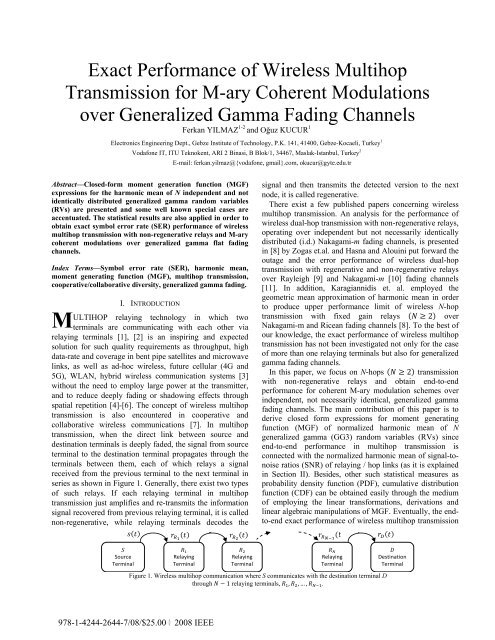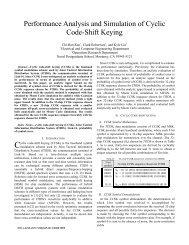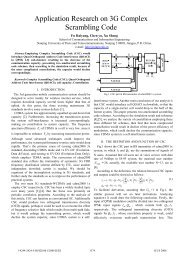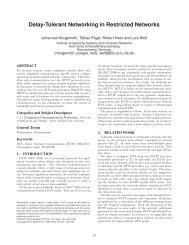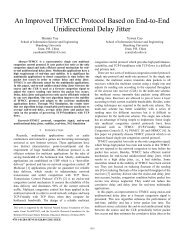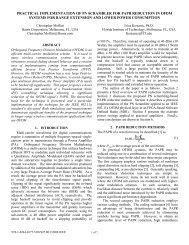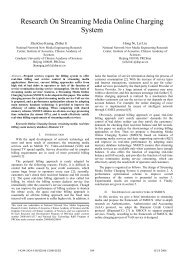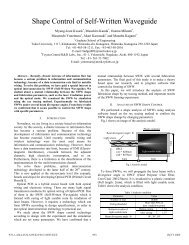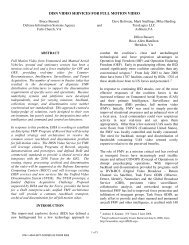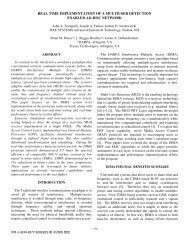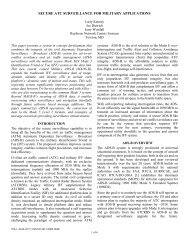Exact Performance of Wireless Multihop Transmission for M-ary ...
Exact Performance of Wireless Multihop Transmission for M-ary ...
Exact Performance of Wireless Multihop Transmission for M-ary ...
Create successful ePaper yourself
Turn your PDF publications into a flip-book with our unique Google optimized e-Paper software.
<strong>Exact</strong> <strong>Per<strong>for</strong>mance</strong> <strong>of</strong> <strong>Wireless</strong> <strong>Multihop</strong><br />
<strong>Transmission</strong> <strong>for</strong> M-<strong>ary</strong> Coherent Modulations<br />
over Generalized Gamma Fading Channels<br />
Ferkan YILMAZ 1-2 and Oğuz KUCUR 1<br />
Electronics Engineering Dept., Gebze Institute <strong>of</strong> Technology, P.K. 141, 41400, Gebze-Kocaeli, Turkey 1<br />
Source<br />
Terminal<br />
Vodafone IT, ITU Teknokent, ARI 2 Binasi, B Blok/1, 34467, Maslak-Istanbul, Turkey 2<br />
Abstract—Closed-<strong>for</strong>m moment generation function (MGF)<br />
expressions <strong>for</strong> the harmonic mean <strong>of</strong> N independent and not<br />
identically distributed generalized gamma random variables<br />
(RVs) are presented and some well known special cases are<br />
accentuated. The statistical results are also applied in order to<br />
obtain exact symbol error rate (SER) per<strong>for</strong>mance <strong>of</strong> wireless<br />
multihop transmission with non-regenerative relays and M-<strong>ary</strong><br />
coherent modulations over generalized gamma flat fading<br />
channels.<br />
Index Terms—Symbol error rate (SER), harmonic mean,<br />
moment generating function (MGF), multihop transmission,<br />
cooperative/collaborative diversity, generalized gamma fading.<br />
M<br />
I. INTRODUCTION<br />
ULTIHOP relaying technology in which two<br />
terminals are communicating with each other via<br />
relaying terminals [1], [2] is an inspiring and expected<br />
solution <strong>for</strong> such quality requirements as throughput, high<br />
data-rate and coverage in bent pipe satellites and microwave<br />
links, as well as ad-hoc wireless, future cellular (4G and<br />
5G), WLAN, hybrid wireless communication systems [3]<br />
without the need to employ large power at the transmitter,<br />
and to reduce deeply fading or shadowing effects through<br />
spatial repetition [4]-[6]. The concept <strong>of</strong> wireless multihop<br />
transmission is also encountered in cooperative and<br />
collaborative wireless communications [7]. In multihop<br />
transmission, when the direct link between source and<br />
destination terminals is deeply faded, the signal from source<br />
terminal to the destination terminal propagates through the<br />
terminals between them, each <strong>of</strong> which relays a signal<br />
received from the previous terminal to the next terminal in<br />
series as shown in Figure 1. Generally, there exist two types<br />
<strong>of</strong> such relays. If each relaying terminal in multihop<br />
transmission just amplifies and re-transmits the in<strong>for</strong>mation<br />
signal recovered from previous relaying terminal, it is called<br />
non-regenerative, while relaying terminals decodes the<br />
E-mail: ferkan.yilmaz@{vodafone, gmail}.com, okucur@gyte.edu.tr<br />
Relaying<br />
Terminal<br />
Relaying<br />
Terminal<br />
signal and then transmits the detected version to the next<br />
node, it is called regenerative.<br />
There exist a few published papers concerning wireless<br />
multihop transmission. An analysis <strong>for</strong> the per<strong>for</strong>mance <strong>of</strong><br />
wireless dual-hop transmission with non-regenerative relays,<br />
operating over independent but not necessarily identically<br />
distributed (i.d.) Nakagami-m fading channels, is presented<br />
in [8] by Zogas et.al. and Hasna and Alouini put <strong>for</strong>ward the<br />
outage and the error per<strong>for</strong>mance <strong>of</strong> wireless dual-hop<br />
transmission with regenerative and non-regenerative relays<br />
over Rayleigh [9] and Nakagami-m [10] fading channels<br />
[11]. In addition, Karagiannidis et. al. employed the<br />
geometric mean approximation <strong>of</strong> harmonic mean in order<br />
to produce upper per<strong>for</strong>mance limit <strong>of</strong> wireless N-hop<br />
transmission with fixed gain relays 2 over<br />
Nakagami-m and Ricean fading channels [8]. To the best <strong>of</strong><br />
our knowledge, the exact per<strong>for</strong>mance <strong>of</strong> wireless multihop<br />
transmission has not been investigated not only <strong>for</strong> the case<br />
<strong>of</strong> more than one relaying terminals but also <strong>for</strong> generalized<br />
gamma fading channels.<br />
In this paper, we focus on N-hops 2 transmission<br />
with non-regenerative relays and obtain end-to-end<br />
per<strong>for</strong>mance <strong>for</strong> coherent M-<strong>ary</strong> modulation schemes over<br />
independent, not necessarily identical, generalized gamma<br />
fading channels. The main contribution <strong>of</strong> this paper is to<br />
derive closed <strong>for</strong>m expressions <strong>for</strong> moment generating<br />
function (MGF) <strong>of</strong> normalized harmonic mean <strong>of</strong> N<br />
generalized gamma (GG3) random variables (RVs) since<br />
end-to-end per<strong>for</strong>mance in multihop transmission is<br />
connected with the normalized harmonic mean <strong>of</strong> signal-tonoise<br />
ratios (SNR) <strong>of</strong> relaying / hop links (as it is explained<br />
in Section II). Besides, other such statistical measures as<br />
probability density function (PDF), cumulative distribution<br />
function (CDF) can be obtained easily through the medium<br />
<strong>of</strong> employing the linear trans<strong>for</strong>mations, derivations and<br />
linear algebraic manipulations <strong>of</strong> MGF. Eventually, the endto-end<br />
exact per<strong>for</strong>mance <strong>of</strong> wireless multihop transmission<br />
Relaying<br />
Terminal<br />
Figure 1. <strong>Wireless</strong> multihop communication where S communicates with the destination terminal D<br />
through 1 relaying terminals, , ,…, .<br />
978-1-4244-2644-7/08/$25.00 © 2008 IEEE<br />
Destination<br />
Terminal
over generalized gamma fading channels is obtained.<br />
The remainder <strong>of</strong> this paper is organized as follows:<br />
Section II introduces wireless multihop transmission and the<br />
fading channel models. Section III presents MGF <strong>of</strong><br />
normalized harmonic mean <strong>of</strong> N independent GG3 RVs and<br />
the obtained results are accentuated <strong>for</strong> such well known<br />
special cases as single-hop and dual-hop transmissions in<br />
literature. Upon applying the obtained results, the end-toend<br />
per<strong>for</strong>mance <strong>of</strong> wireless multihop transmission with<br />
nonregenerative relays is evaluated in Section IV. Finally,<br />
Section V summarizes the main results <strong>of</strong> the paper.<br />
II. MULTIHOP TRANSMISSION<br />
Consider a multihop (N-hop) wireless transmission as<br />
shown in Figure 1, which operates over independent and not<br />
identically distributed GG3 fading channels, the source<br />
terminal S and destination terminal D are too far apart <strong>for</strong> a<br />
single link within the sight <strong>of</strong> power constraints and channel<br />
fading effects. However, they can be connected using<br />
multiple wireless links arranged in an end-to-end<br />
configuration such that the source terminal S communicates<br />
with the destination terminal D through 1 relaying<br />
terminals ,,…,. Clearly, these terminals relay the<br />
in<strong>for</strong>mation signal only from one hop to the next, acting as<br />
nonregenerative relays. All relaying terminals concurrently<br />
receive and transmit in the same frequency band, and no<br />
latency is incurred in the whole chain <strong>of</strong> relaying<br />
transmissions and there is no wireless multihop diversity.<br />
Assume that the source terminal S transmits a signal ,<br />
which has an average power normalized to one, to the<br />
destination terminal D through relaying terminals. The<br />
received signal at the first terminal can be written as<br />
, (1)<br />
where is the fading amplitude <strong>of</strong> the channel between<br />
source terminal S and the first relaying terminal and<br />
, is an additive white Gaussian noise (AWGN) signal<br />
with one sided power spectral density, ,. After the<br />
received signal at the first terminal is multiplied with which is the gain, it is retransmitted to the next relaying<br />
terminal (the second relaying terminal) . The received<br />
signal at the second relaying terminal can be written as<br />
, , (2)<br />
where is the fading amplitude <strong>of</strong> the channel between the<br />
first relaying terminal and the second relaying terminal<br />
and , is an AWGN signal with one sided power<br />
spectral density, ,. In the same manner, the received<br />
signal at the second terminal is multiplied with and<br />
retransmitted to the next terminal (the third relaying<br />
terminal) . The received signal at the third relaying<br />
terminal can be written as<br />
<br />
(3)<br />
, , , where is the fading amplitude <strong>of</strong> the channel between the<br />
second relaying terminal and the third relaying terminal<br />
and , is an AWGN signal with one sided power<br />
spectral density, ,. Finally, at the end <strong>of</strong> whole chain <strong>of</strong><br />
relaying transmissions, the received signal at the destination<br />
terminal D can be given as [3]<br />
<br />
, <br />
<br />
<br />
<br />
<br />
with 1. Then, it is straight<strong>for</strong>ward that the end-to-end<br />
signal-to-noise ratio (SNR), i.e., the SNR at destination<br />
terminal D, can be written as [4]<br />
<br />
(4)<br />
<br />
<br />
, <br />
(5)<br />
<br />
<br />
<br />
<br />
<br />
It is clear from (5) that the choice <strong>of</strong> the relay gain<br />
determines the equivalent SNR between source and<br />
destination terminals. One choice <strong>for</strong> the gain is [4]<br />
1⁄ <br />
(6)<br />
where the relay just amplifies the incoming signal with the<br />
inverse <strong>of</strong> the channel fading amplitude <strong>of</strong> the previous hop,<br />
regardless <strong>of</strong> the noise <strong>of</strong> that hop. As mentioned in [4],<br />
such a relaying technique serves as a benchmark <strong>for</strong> all<br />
practical multihop systems employing non-regenerative<br />
relays. By applying (6) into (5), the end-to-end<br />
instantaneous SNR (the instantaneous SNR at destination<br />
terminal D) becomes<br />
1<br />
<br />
1<br />
<br />
1<br />
<br />
<br />
1<br />
(7)<br />
where the instantaneous SNRs , 1,2,…, are given as<br />
,<br />
(8)<br />
Here, the amplitude fading , 1,2,…, <strong>of</strong> relays in<br />
wireless multihop transmission are modeled as GG3 fading<br />
[12]. Consequently, the PDF <strong>of</strong> instantaneous SNRs <strong>of</strong> hops,<br />
, can be expressed as follows<br />
Γ <br />
<br />
Ω exp <br />
<br />
Ω (9)<br />
over 0 ∞, where Γ 1⁄ ⁄ Γ and<br />
1⁄ 2,<br />
0 are such two parameters as the fading<br />
parameter, the shape parameter, respectively, related to<br />
fading severity. Ω is the power-scaling parameter <strong>of</strong> the<br />
random variable, defined as Ω , with . <br />
denoting expectation operator. Additionally, GG3 fading<br />
model covers a wide range <strong>of</strong> fading conditions <strong>for</strong> different<br />
shape parameter and fading figure values. Such commonly<br />
employed fading models in literature as the Rayleigh <br />
ξ1, Nakagami-m ξ 1, Weibull 1, lognormal<br />
∞,ξ0, and AWGN ∞,ξ1 are special<br />
or limiting cases <strong>of</strong> the generalized gamma distribution.<br />
Ricean fading can also be closely approximated by<br />
generalized gamma fading if the shape parameter ξ1 and<br />
the relationship 21⁄ 2 1 between the
Ricean factor κ and the fading figure, m exists. As a step<br />
<strong>for</strong>ward, using definition <strong>of</strong> MGF / (one-sided) Laplace<br />
trans<strong>for</strong>m given as<br />
|,,Ω <br />
| , ,Ω <br />
<br />
(10)<br />
where · | is the Laplace trans<strong>for</strong>mation operator<br />
with respect to x and exploiting Mellin-Barnes integral, we<br />
can easily derive Moment Generating Function (MGF) as<br />
follows<br />
, Ω H, <br />
1 , 1<br />
<br />
,0<br />
(11)<br />
0,1<br />
,<br />
where H, ·, ,,, is Fox’s H function defined<br />
in [13], [14].<br />
III. STATISTICAL BACKGROUND<br />
In order to study important statistical metrics <strong>of</strong> the end-toend<br />
SNR, MGF <strong>of</strong> the normalized harmonic mean <strong>of</strong> the<br />
GG3 RVs given in (7) can be given as follows<br />
<br />
<br />
<br />
<br />
1⁄ 1⁄ 1⁄ <br />
<br />
|,, Ω … <br />
(12)<br />
After algebraic manipulations based Mellin-Barnes integrals<br />
and Fox’s H functions [14], we have obtained exact MGF <strong>of</strong><br />
the end-to-end SNR <strong>for</strong> wireless multihop transmission as<br />
follows<br />
<br />
2√H ,<br />
where H is defined as<br />
<br />
<br />
, Δ,∞ H, H, <br />
Δ1,1, Δ, <br />
<br />
<br />
Ω <br />
, Δ,∞ H, <br />
Δ0,1, Δ, <br />
<br />
<br />
Ω <br />
(13)<br />
(14)<br />
where Δ, and are the parameters <strong>of</strong> Fox’s H<br />
function defined as<br />
1<br />
Δ, ,<br />
<br />
1<br />
(15)<br />
<br />
<br />
<br />
<br />
Ω <br />
<br />
(16)<br />
Finally, let us consider some special cases in order to check<br />
analytical simplicity and accuracy:<br />
A. Special Case I (Single-hop special case): Most <strong>of</strong> the<br />
investigated communications systems in literature are based<br />
on single-hop, which is the special case <strong>of</strong> wireless multihop<br />
transmission such that there is no relaying terminal in the<br />
transmission (total number <strong>of</strong> hops 1). Besides, most <strong>of</strong><br />
the results <strong>for</strong> single-hop communications systems are given<br />
<strong>for</strong> Nakagami-m fading channels. Then, we can simplify<br />
MGF given in (13) <strong>for</strong> single-hop Nakagami-m <br />
0.5, 1 fading channels as follows<br />
<br />
ΩΓ <br />
, <br />
2√H, <br />
Ω <br />
<br />
0,1, 1,1 <br />
<br />
(17)<br />
<br />
Using Fox’s H function equality [13, eq. (2.9.19)],<br />
, <br />
H, <br />
4 <br />
<br />
<br />
2<br />
,1 , <br />
2<br />
,1 2<br />
2 <br />
<br />
, (18)<br />
where , and is the nth-order modified Bessel<br />
function <strong>of</strong> second kind, we simplify the MGF as<br />
2<br />
Γ <br />
Ω <br />
<br />
<br />
<br />
<br />
2√ 2 <br />
Ω <br />
<br />
(19)<br />
<br />
Then, substituting the integral equality [15, eq. (3.16.11.7)]<br />
into (19) gives MGF <strong>for</strong> Nakagami-m fading channels as<br />
follows<br />
1 Ω<br />
<br />
<br />
(20)<br />
which is well-known in literature [16, eq. (5.15)], [17].<br />
B. Special Case II (Balanced double-hop special case): For<br />
the case in which there is one relaying terminal in the<br />
transmission 2, we can simplify MGF given in (13)<br />
<strong>for</strong> Nakagami-m 0.5, 1<br />
fading channels as follows<br />
2<br />
ΩΓ 2√ <br />
<br />
<br />
, <br />
H, <br />
Ω <br />
<br />
1<br />
2 ,1,1<br />
2 ,1<br />
, <br />
H, <br />
Ω <br />
<br />
1<br />
2 ,1,1<br />
2 ,1<br />
(21)<br />
in which replacing Fox’s H equality given in (18) gives<br />
<br />
<br />
<br />
<br />
8<br />
Γ <br />
Ω <br />
2√<br />
<br />
<br />
2 <br />
Ω 2 <br />
Ω <br />
(22)<br />
Finally, upon employing [15, eq. (8.4.23.29)], MGF <strong>for</strong><br />
Nakagami-m fading channels is obtained as follows<br />
, 2; 1 Ω<br />
;<br />
2 4 <br />
(23)<br />
which has been already proposed in [10, eq. (5)], where<br />
·,·;·;· is the Gauss’ hypergeometric function defined in<br />
[18, eq.(15.1.1)]. If the fading figure 1 (i.e. it is the<br />
balanced double-hop transmission over Rayleigh fading<br />
channels), then (23) reduces into [9, eq. (21)].
C. Special Case III (Balanced triple-hop special case): For<br />
the case in which there exists two relaying terminals in<br />
transmission (total number <strong>of</strong> hops is 3), we can easily<br />
simplify MGF given in (13) <strong>for</strong> Nakagami-m <br />
0.5, 1 fading channels as<br />
follows<br />
<br />
<br />
24<br />
Γ <br />
Ω <br />
<br />
<br />
2√ 2<br />
<br />
<br />
Ω 2 <br />
Ω <br />
(24)<br />
This integral can be easily taken by means <strong>of</strong> substituting<br />
power series <strong>of</strong> Bessel functions into (24). Then, the MGF,<br />
having not proposed in literature yet, is obtained as follows<br />
3√<br />
<br />
2 <br />
Γ 1<br />
<br />
<br />
Ω<br />
<br />
<br />
∞<br />
<br />
! !<br />
<br />
<br />
,<br />
G, 4 <br />
23<br />
,<br />
3<br />
133<br />
3<br />
, 6 1<br />
6<br />
2 3 2<br />
3<br />
,<br />
3<br />
, 6 2<br />
(25)<br />
<br />
3<br />
,<br />
where G, ·, ,,, is the MeijerG function<br />
defined in [19, eq. (9.301)]. However, this obtained MGF<br />
has singularity while expressing per<strong>for</strong>mance expression <strong>for</strong><br />
M-PSK modulation schemes. In order to avoid this problem,<br />
we can apply Laguerre Trans<strong>for</strong>mation [20] onto MGF.<br />
Consequently, we obtain the MGF as follows<br />
3√<br />
<br />
2 <br />
Γ <br />
<br />
Ω Ω<br />
<br />
<br />
∞<br />
L (26)<br />
!<br />
<br />
where L is defined as<br />
L 1 <br />
<br />
,<br />
G, 4 <br />
!<br />
23<br />
,<br />
3<br />
133<br />
3<br />
, 6 1<br />
6<br />
2 3 2<br />
3<br />
,<br />
3<br />
, 6 2<br />
<br />
(27)<br />
<br />
3<br />
D. Special Case IV (Balanced N-hop special case): For the<br />
case that there are 1 relaying terminals in the system,<br />
(the total number <strong>of</strong> hops is ), we can simplify MGF <strong>for</strong><br />
Nakagami-m 0.5, 1 fading channels, which has not<br />
proposed in literature yet, as follows<br />
2<br />
Γ <br />
Ω <br />
∞<br />
<br />
2√ <br />
<br />
2 <br />
Ω 2 <br />
Ω <br />
(28)<br />
MGF <strong>for</strong> different hop counts is depicted in Figure 2 by<br />
means <strong>of</strong> using (28). If the total number <strong>of</strong> relaying<br />
terminals in transmission goes to infinity ∞, the<br />
MGF becomes<br />
lim<br />
∞ 1, 0<br />
0, (29)<br />
which means that the per<strong>for</strong>mance <strong>of</strong> wireless multihop (Nhop)<br />
transmission deteriorates when increases, i.e., lower<br />
limit symbol error rate (SER) per<strong>for</strong>mance <strong>of</strong> wireless<br />
multihop transmission <strong>for</strong> M-PSK signaling is ⁄ 1<br />
error/symbol, where is the modulation level, <strong>for</strong> DPSK /<br />
BPSK is 0.5 error/symbol. As a result, total number <strong>of</strong> hops<br />
is limited with respect to the desired per<strong>for</strong>mance and<br />
coverage.<br />
Figure 2. The variation <strong>of</strong> MGF <strong>for</strong> different hop counts (fading figures<br />
, 2, shaping parameters , 1 and average powers , Ω <br />
1 , 1,2, … , )<br />
IV. PERFORMANCE EVALUATION<br />
Having the MGF <strong>of</strong> the end-to-end instantaneous SNR, and employing the MGF-based approach <strong>for</strong> the<br />
per<strong>for</strong>mance evaluation <strong>of</strong> digital modulations over fading<br />
channels [16], the obtained MGF result in (13) enables us to<br />
obtain SER per<strong>for</strong>mance <strong>for</strong> various M-<strong>ary</strong> modulations<br />
[such as M-<strong>ary</strong> phase shift keying (MPSK), M-<strong>ary</strong><br />
differential phase shift keying (MDPSK), and M-<strong>ary</strong><br />
quadrature amplitude modulation (MQAM)] as follows<br />
<br />
<br />
<br />
V 2Λ (30)<br />
<br />
where , , , V, Λ and are the per<strong>for</strong>mance<br />
parameters <strong>for</strong> M-<strong>ary</strong> modulation which are given in Table<br />
I. For instance, the per<strong>for</strong>mance expression <strong>for</strong> coherent<br />
MDPSK modulations is easily reduced to [16]<br />
<br />
<br />
2<br />
<br />
2 <br />
<br />
1 <br />
<br />
2 <br />
<br />
(31)<br />
<br />
In literature, the most <strong>of</strong> the per<strong>for</strong>mance results<br />
concerning wireless multihop transmission are given <strong>for</strong><br />
bin<strong>ary</strong> DPSK (BDPSK). On account <strong>of</strong> that, Figure 3<br />
compares the bit error rate (BER) per<strong>for</strong>mances <strong>of</strong> wireless<br />
multihop transmission with non-regenerative relays and<br />
DPSK modulation <strong>for</strong> different hop counts. Similar to the<br />
MGF results obtained from Figure 2, it is clear that the<br />
number <strong>of</strong> hops increases then the per<strong>for</strong>mance deteriorates.<br />
There<strong>for</strong>e, total number <strong>of</strong> hops in transmission is limited<br />
with respect to the desired per<strong>for</strong>mance and coverage under
TABLE I<br />
PARAMETERS FOR SPECIFIC MODULATIONS<br />
M-<strong>ary</strong><br />
Modulation<br />
Schemes<br />
V Λ MPSK 1<br />
MDPSK 1<br />
MQAM 2<br />
MPAM 1<br />
1<br />
<br />
2<br />
<br />
4√ 4<br />
√<br />
44√<br />
√<br />
2 2<br />
<br />
1<br />
0 <br />
2<br />
<br />
<br />
1 <br />
<br />
0 1<br />
2<br />
0 1<br />
2<br />
0 1<br />
2<br />
the assumption that there is no multihop diversity in the<br />
transmission. Besides, if the fading figure increases (i.e.<br />
the channel fading conditions improve), the per<strong>for</strong>mance <strong>of</strong><br />
wireless multihop transmission with nonregenerative relays<br />
will converge to the per<strong>for</strong>mance <strong>of</strong> BDPSK over AWGN<br />
channels.<br />
Figure 3. BER per<strong>for</strong>mance <strong>of</strong> wireless multihop transmission with nonregenerative<br />
relays (fading figures , 1,2, shaping parameters<br />
, 1, 1,2, … , ).<br />
V. CONCLUSION<br />
<br />
<br />
<br />
<br />
<br />
<br />
3⁄ 2<br />
1<br />
3⁄ 2<br />
1<br />
3<br />
1<br />
The parameters <strong>for</strong> such common coherent modulations as M-<strong>ary</strong> phase shift<br />
keying (MPSK), M-<strong>ary</strong> differential phase shift keying (MDPSK), M-<strong>ary</strong> square<br />
quadrature amplitude modulation (MQAM) with and even, M-<strong>ary</strong> pulse amplitude<br />
modulation (MPAM).<br />
In this paper, we presented not only the exact and<br />
generalized per<strong>for</strong>mance <strong>of</strong> wireless multihop (N-hop)<br />
transmission 2 with nonregenerative relays <strong>for</strong> M-<strong>ary</strong><br />
modulations over generalized gamma (GG3) fading<br />
channels but also the MGF <strong>of</strong> the normalized harmonic<br />
mean <strong>of</strong> N GG3 random variables by means <strong>of</strong> Mellin-<br />
Barnes integrals and Fox’s H functions. Such special cases<br />
<strong>of</strong> multihop transmission as single-hop, balanced doublehop,<br />
balanced triple-hop and balanced N-hop are<br />
accentuated <strong>for</strong> Nakagami-m and Rayleigh fading channels.<br />
<br />
2<br />
<br />
4<br />
<br />
2<br />
Furthermore, the exact generalized per<strong>for</strong>mance expression<br />
is presented <strong>for</strong> M-<strong>ary</strong> modulation schemes and the<br />
per<strong>for</strong>mance <strong>for</strong> BDPSK modulation is depicted on the<br />
purpose <strong>of</strong> comparing the obtained results <strong>for</strong> wireless<br />
double-hop transmission with the literature. Besides, it is<br />
shown that there is a threshold between number <strong>of</strong> hops and<br />
the desired per<strong>for</strong>mance and coverage when there is no<br />
multihop diversity in the transmission.<br />
[1]<br />
REFERENCES<br />
J. N. Laneman, D. N. C. Tse, and G. W. Wornell, “A per<strong>for</strong>mance<br />
study <strong>of</strong> dual-hop transmissions with fixed gain relays,” IEEE Trans.<br />
<strong>Wireless</strong> Communications, vol. 3, no. 6, pp. 1963–1968, Nov. 2004.<br />
[2] J. Boyer, D. D. Falconer, and H. Yanikomeroglu, “<strong>Multihop</strong> diversity<br />
in wireless relaying channels,” IEEE Transactions on<br />
[3]<br />
Communications, vol. 52, no. 10, pp. 1820–1830, Oct. 2004.<br />
Special issue on “Energy-aware ad hoc wireless networks,” IEEE<br />
<strong>Wireless</strong> Communications, vol. 9, Aug. 2002.<br />
[4] M.O. Hasna and M.S. Alouini, “Outage probability <strong>of</strong> multihop<br />
transmission over Nakagami fading channels,” IEEE Communications<br />
Letters, vol.7, pp. 216–218, May 2003.<br />
[5] J. Boyer, D.D. Falconer , and H. Yanikomeroglu, “<strong>Multihop</strong> diversity<br />
in wireless relaying channels,” IEEE Transactions on<br />
[6]<br />
Communications, vol. 52, pp. 1820–1830, Oct. 2004.<br />
P.A. Anghel and M. Kaveh, “<strong>Exact</strong> symbol error probability <strong>of</strong> a cooperative<br />
network in a Rayleigh-fading environment,” IEEE Transac.<br />
<strong>Wireless</strong> Communications, vol. 3, pp. 1416–1421, Sept. 2004.<br />
[7] A. Sendonaris, E. Erkip and B. Aazhang, “Increasing uplink capacity<br />
via user cooperation diversity,” in Proc. IEEE Int. Symp. In<strong>for</strong>mation<br />
Theory (ISIT’98), pp. 156, Cambridge, MA, Aug. 1998.<br />
[8] G. K. Karagiannidis, D. A. Zogas, N. C. Sagias, T. A. Tsiftsis, and P.<br />
T. Mathiopoulos, “<strong>Multihop</strong> communications with fixed-gain relays<br />
over generalized fading channels,” in Proc. IEEE Global<br />
[9]<br />
Telecommunications Conference, vol. 1, pp. 36-40, Dallas, Texas,<br />
USA, Dec. 2004.<br />
M.O. Hasna and M.S. Alouini, “End-to-end per<strong>for</strong>mance <strong>of</strong><br />
transmission systems with relays over Rayleigh fading channels,”<br />
IEEE Transaction on <strong>Wireless</strong> Communications, vol. 2, pp. 1126–<br />
1131, Nov. 2003.<br />
[10] M.O. Hasna and M.S. Alouini, “Harmonic mean and end-to-end<br />
per<strong>for</strong>mance <strong>of</strong> transmission systems with relays,” IEEE Transactions<br />
<strong>of</strong> Communications, vol. 52, pp. 130–135, Jan. 2004.<br />
[11] M.O. Hasna and M.S. Alouini, “A per<strong>for</strong>mance study <strong>of</strong> dual-hop<br />
transmissions with fixed gain relays,” IEEE Trans. <strong>Wireless</strong><br />
Communications, vol. 3, pp. 1963–1968, Nov. 2004.<br />
[12] E.W. Stacy, “A generalization <strong>of</strong> the Gamma distribution,” The<br />
Annals <strong>of</strong> Mathematical Statistics, vol. 3, no. 33 pp. 1187–1192, Sep.<br />
1962.<br />
[13] A.A. Kilbas and Megumi Saigo, H-Trans<strong>for</strong>ms: Theory and<br />
Applications, CRC Press LLC, 2004.<br />
[14] Charles Fox, “The G and H Functions as Symmetrical Fourier<br />
Kernels,” Transactions <strong>of</strong> the American Mathematical Society, vol.<br />
98, no. 3, pp. 395-429, March, 1961.<br />
[15] A.P. Prudnikov, Yu.A. Brychkov, and O.I. Marichew, Integrals and<br />
series, vol. 1-5, Gordon & Breach, 1986-1992.<br />
[16] M.K. Simon, and M.S. Alouini, Digital Communication over Fading<br />
Channels, 2nd ed., John Wiley & Sons, Inc., Hoboken, New Jersey.<br />
[17] M.S. Alouini and A.J. Goldsmith, “A unified approach <strong>for</strong> calculating<br />
error rates <strong>of</strong> linearly modulated signals over generalized fading<br />
channels,” IEEE Trans. Comm., vol. 47, pp. 1324-1334, Sept. 1999.<br />
[18] M. Abramowitz and I. A. Stegun, Handbook <strong>of</strong> Mathematical<br />
Functions with Formulas, Graphs, and Mathematical Tables, 9th ed.<br />
New York: Dover, 1970.<br />
[19] I. S. Gradshteyn and I. M. Ryzhik, Table <strong>of</strong> Integrals, Series, and<br />
Products, 5th ed. San Diego, CA: Academic, 1994.<br />
[20] Joseph McCully, “The Laguerre Trans<strong>for</strong>m,” SIAM Review, vol. 2,<br />
no. 3, pp. 185-191, Jul. 1960.


